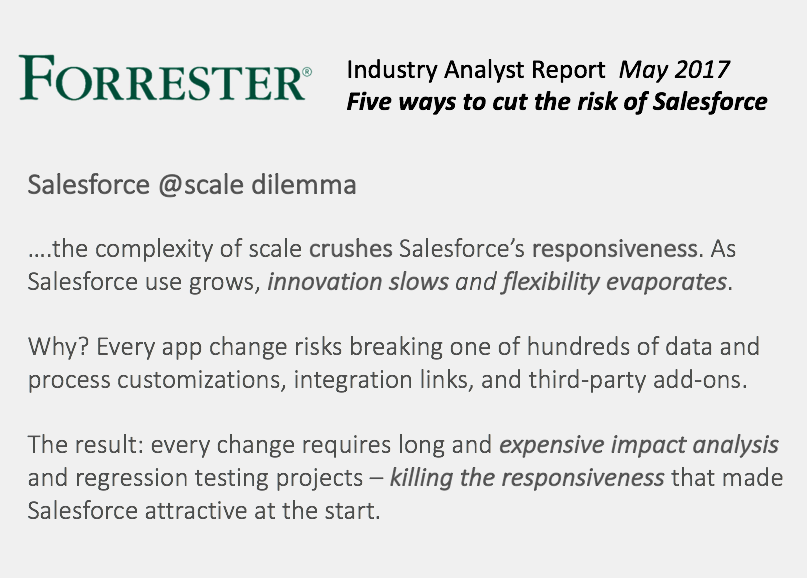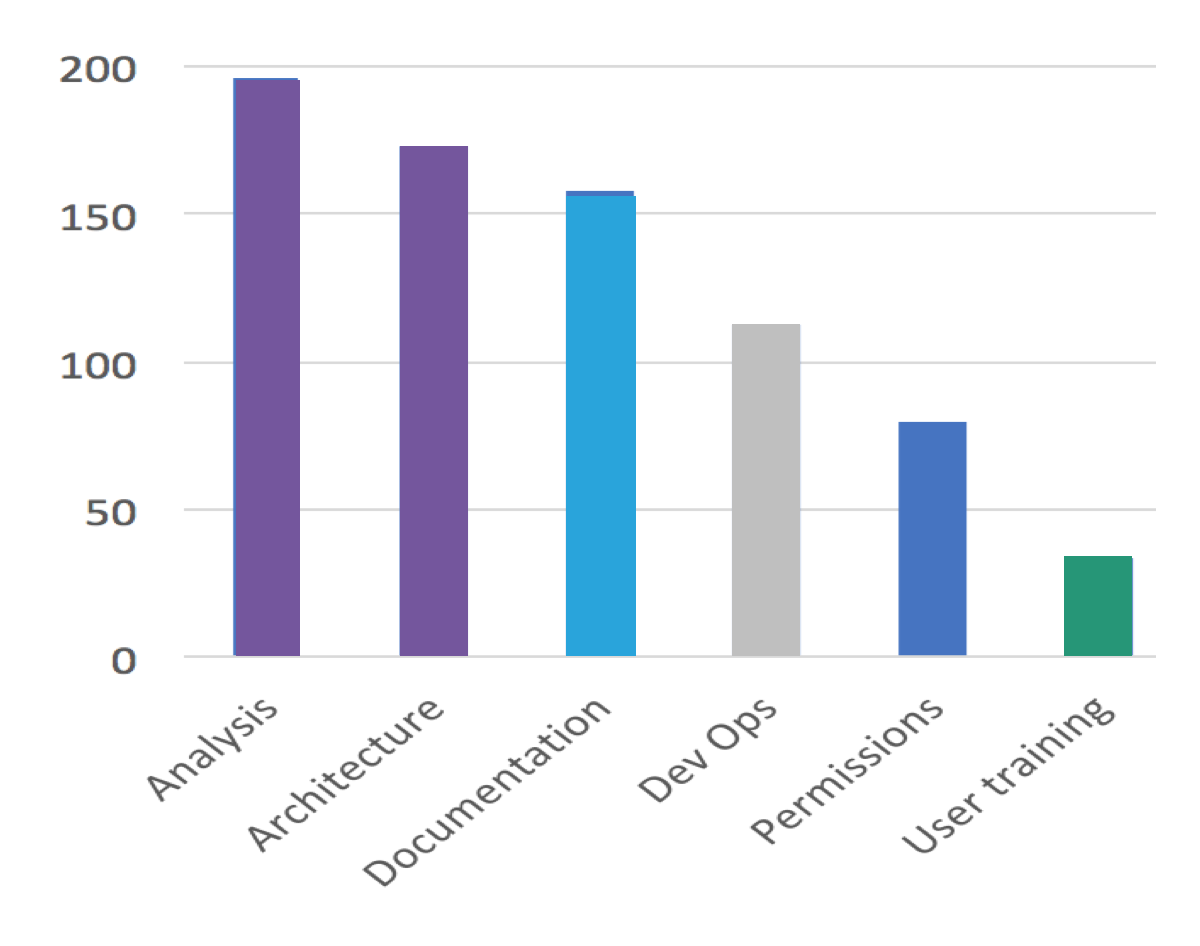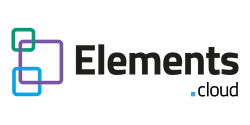After completing this unit, you’ll be able to:
- Understand how time consuming a messy Org is
- Understand the tools available
- Build a business case
PREREQUISITES
You need access to Elements Catalyst so you will need to run a free 14 day trial.
#1 ISSUE
Call it technical debt, uncontrolled agility, or a messy Org. It kills agility and user adoption. It is the #1 reason why Orgs are not migrating to Lightning.
When Salesforce was tactical and had a narrow scope, developing with limited or no documentation was (probably) acceptable. It was not recommended, but it was the norm. But to have a strategic app that is critical to the ongoing operation of the organization with no documentation is an unnecessary risk business and IT professionals must avoid, and if not addressed, may be perceived as negligent.
Every Org is constantly evolving. This can be incremental changes to tweak and improve the user experience, major projects to implement new functionalities, migration from Classic to Lightning, CPQ implementation or enabling the features inherent with Einstein capabilities. Changes need to build on the existing configured Org. To do this with any level of confidence requires decent documentation of what has been built before. An implementation with no clear documentation of what has been configured – and (most importantly) why – means that it is very difficult, if not impossible, to support, maintain and improve.
We often hear of clients that have “broken” their Org. What does that mean? A change or deletion of a field means that automation does not work or Apex code does not work correctly or a workflow is disrupted. Or worse, a field that is used in an external integration or an Einstein prediction is removed or changed.
Documentation is often left to the end of the project and it is the first thing to get cut when deadlines loom and budgets are tight. Sometimes documentation is created, but often in a spreadsheet or textual document. This lacks the context or linkage back to the customization of Salesforce, so it doesn’t get maintained and rapidly gets out of date.
Migration to lightning amplifies the problem. Lightning Experience gives ultimate configurability, further reinforcing the agility developers and admins have at their disposal. Dynamic components easily accessed from a palette or created by the developer further extend the platform’s capabilities. Data from multiple objects can be dropped onto a single page using standard or 3rd party components. Pages can be designed to support every use case. As a result, an experienced admin viewing a newly migrated Lightning version of their Org could look at the configuration and not even recognize the Lead or Account objects.
This is why it is even more important to document why you have configured things as you have. Your Lightning migration project is the perfect time to start the documentation habit. But for now, you need to get from Classic to Lightning as quickly as possible with as little effort as possible, and at the same time improving the user experience. What’s an admin to do?
DOCUMENTATION DEBT KILLS AGILITY, SLOWS INNOVATION & WASTES TIME
Technical debt is a concept in software development that reflects the implied cost of additional rework caused by choosing an easy solution now instead of using a better approach that would take longer. Short term gain, long term pain.
The issue we are all facing is documentation debt. We make changes to an area of the Org but don’t take the time to document what and why. We just need to get it out. Then we come back 6 months, 6 weeks or 6 days later and want to make further changes to the same area – but can’t remember what was done. So it takes hours of investigative work. This is documentation debt.
Documentation debt has a real impact. One of the reasons for Salesforce’s huge success is that it is so easy to configure using drag and drop. It doesn’t require lots of coding. But documentation debt kills that agility.
Even the simplest change could potentially impact different areas of the business. Currently, one option is to look in Salesforce Setup and do a ton of detective work. There are so many configuration options, the risk is that you miss something, break the Org and stop the business operating. Another option is to create new customizations rather than change the existing ones. This bloats the Org with multiple similar objects, fields, flows and validation rules, process builder scripts, workflows, and more.

ORG HEALTH CHECK
“I know my Org’s sick. But how bad is it, Doc?” There are 3 reports that can give you an overview
- Salesforce Optimizer
- Salesforce Lightning Experience Readiness Report
- Elements Catalyst Org Analytics
The reports are great tools that any Admin can run. But like your annual medical checkup, they give you an overall – high level – view of the health of your Org. They do not get into the nitty gritty detail that you need to make changes with speed and confidence. That is where a metadata dictionary with impact analysis becomes a valuable tool. (More of that in the next unit). You probably already know the major pain points in your Org. You get support calls and complaints from your users. What you need is the approach and tools to make changes that have a noticeable, positive impact: improved user adoption, and more productive and happier users.
ROI FOR CLEAN UP
Elements Catalyst will make your tasks easier, but that is not really good enough. Your manger requires a business case and then you need to find some budget. We’ve built an ROI calculator spreadsheet. You can download the ROI spreadsheet here .
The spreadsheet has 2 sheets – BENEFITS which lists the areas of benefits and the Elements capabilities that you use to deliver the benefits. The CALCULATION sheet has some of the base metrics that measure increased productivity and effectiveness.
There are 3 areas where measurable benefits emerge: business analysis, Org cleanup & documentation, and feedback & training. Each works with the others seamlessly whether yours is a mature Org going through a Classic to Lightning Migration, additions to the user population and/or a new build.
Business Analysis
This covers process mapping, data modeling and requirements capture. Our experience is that companies can get up to 25% business productivity improvements simply by streamlining operational processes and removing waste. That is without implementing new apps.
There are huge benefits if you get a clear understanding of the operational processes BEFORE you start configuring. First, you get the benefits of streamlining the processes which will give you immediate productivity improvements. Secondly, you avoid expensive rework because you are building what end users really need – not what they thought that they might need. You will be surprised how much the requirements change once you really lock them down in the context of the business processes. Next, the process maps and linked information is valuable training material so end users can find what they want more easily. Not surprisingly this is the largest benefit. Finally, the process contents supports your regulatory compliance.
Clean up & documentation
A recent IDC report called the Future of Work estimated that “40% of development time is spent dealing with ‘technical debt’”. The root cause analysis of the 450+ OrgConfessions is eye-opening. Poor business analysis and a lack of documentation are #1 and #3. Both of these a major contributors to technical debt.

What is not included in the 40% that the IDC survey identified is the effort spent on impact analysis of every change because you have no idea what fields are used. And then there is the firefighting when you make a change and the Org breaks unexpectedly. You are fighting objects with maxed out fields, but you’re guessing many of them are never used. Or you are trying to debug an automation. This slows everything down.
Users could be more effective if page layouts didn’t look like CVS receipts due to the number of fields. Finally, there is the time wasted looking for documentation stored on shared drives. And once you have found it, can you be confident it is the correct copy?
A study back in 2008 by Herman Miller commented the time lost by “information overload” is 20% for knowledge workers. And that has only gotten worse with the proliferation of apps where documents could be stored An industrial client ran a test and discovered that our process-led approach to documentation made it 34x faster to find the right information in context. And that last word is crucial – “context”. The best place to find a spec is attached to the metadata items that are impacted.
Feedback & training
You’ve spent all that effort on building the app and if the end users don’t use it properly you end up with poor data and awful adoption. What is the cost of fixing data? What about responding to the same questions again and again? Have you estimated the time wasted with end users struggling to use the app?
The morale boost, productivity enhancements, and increase in adoption from responding really quickly to end user feedback should not be overlooked. It all starts with engagement – giving end users a simple method to post feedback, inside the page layout. Once agreed upon, updates to training materials, policy and procedures and other materials quickly show your users you are listening and value their input.
There are some simple, quick wins. Removing unused fields from page layouts speeds up load time, reduces end user visual overload and the potential for poor data. Finally, target the key fields where data quality is critical or there is end user confusion: picklists, mandatory fields, fields that kick off workflow. Provide additional help that is easily accessed in context.
The Herman Miller story of information overload is just as relevant here. The sales team will be more effective if the published proposal template is linked to the Opportunity object, or to a step in the proposal process which is accessed inside Opportunity object.
Lightning Migration
There are clear business benefits when you migrate to Lightning. Salesforce’s own research of over 500 companies who had made the switch makes compelling reading: 31% less time managing pipe and 28% less time standardizing processes, with 21% uplift in win rates, 29% faster reporting, 40% improved collaboration, and 41% higher productivity.
So if you could migrate to Lightning faster by quicker Org analysis, could you pull forward these business benefits? What is the business value? These could easily overshadow the benefits of the reduced migration effort.
Next up, how you use the metadata dictionary to help understand and then cleanup your Org
=======================================================================
NEXT: Metadata dictionary
